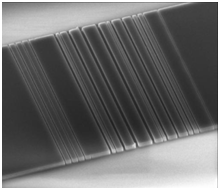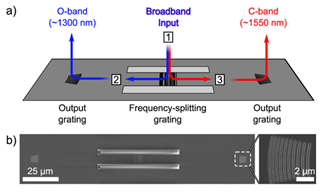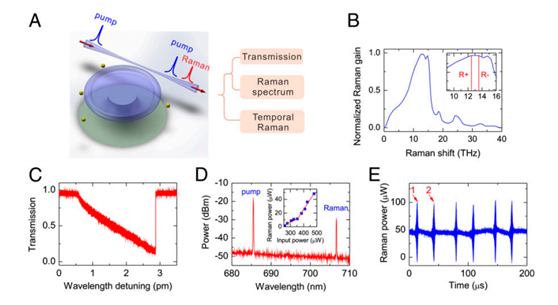Published: 2014.11.27
内容介绍:
纳米光子学器件在光控制芯片上体现出了巨大的作用,但直至目前,所有的集成光子器件的设计,包括各式各样的定向耦合器、MMI、环形谐振腔、taper和光栅耦合器等都是基于Maxwell方程组,通过扫描波导的宽度、高度、周期性等参数来找到器件的最佳设计方案,这种方法可调的参数很少,同时非常笨拙低效。本文提出了一种全新的反向设计的技术,通过给定目标光场的限制参数,反向设计出器件的结构,并通过这种方法实现了波分解复用的光栅。它接收垂直入射的高斯光束,并将O-band(1300nm)和C-band光从不同的输出口输出。这种反向设计的技术具有很强的通用性,还能够应用到很多其它器件的设计上,如滤波器,模式转换器,模式复用器件等,具有巨大的应用价值。

图1 波分解复用光栅的电镜图

图2 波分解复用器件的原理图及结构图
Published: 2014.9.9
内容介绍:
超灵敏度纳米颗粒探测在疾病早期诊断和环境监测中具有重要的应用。本文第一次报道了利用高Q值微腔拉曼散射模式分裂效应产生的拍频信号来监测单纳米颗粒。作者首先利用taper型光纤来转移50nm半径的纳米颗粒的位置来实现单纳米颗粒的探测,接着又在水环境中实现了20nm半径单纳米颗粒的实时探测。由于大多数材料在很宽的泵浦光波长范围下都能够产生拉曼散射,因此这种方法避免了在微腔中进行掺杂来产生增益,同时对泵浦光的波长也没有太高的要求,因此在高灵敏度的传感领域具有重要的作用。

图1微腔拉曼激光器的测试装置 (A)taper-圆盘耦合系统原理图,输出光包括泵浦光和拉曼光,从三个端口输出,分别监测(C)泵浦光透射谱(D)拉曼光谱(E)实时拉曼光功率。(B)硅体材料的归一化拉曼增益。R+和R-分别代表两束分裂的拉曼腔模式
二、 简讯:
DOI:10.1038/nature13875
Published: 2014.12.3
Abstract:
Terahertz-frequency optical pulses can resonantly drive selected vibrational modes in solids and deform their crystal structures. In complex oxides, this method has been used to melt electronic order, drive insulator-to-metal transitionsand induce superconductivity. Strikingly, coherent interlayer transport strongly reminiscent of superconductivity can be transiently induced up to room temperature (300 kelvin) in YBa2Cu3O6+x. Here we report the crystal structure of this exotic non-equilibrium state, determined by femtosecond X-ray diffraction and ab initio density functional theory calculations. We find that nonlinear lattice excitation in normal-state YBa2Cu3O6+x at above the transition temperature of 52 kelvin causes a simultaneous increase and decrease in the Cu–O2 intra-bilayer and, respectively, inter-bilayer distances, accompanied by anisotropic changes in the in-plane O–Cu–O bond buckling. Density functional theory calculations indicate that these motions cause drastic changes in the electronic structure. Among these, the enhancement in the  character of the in-plane electronic structure is likely to favour superconductivity.
character of the in-plane electronic structure is likely to favour superconductivity.
DOI: 10.1126 /science.1258479
Published: 2014.10.30
Effective manipulation of cavity resonant modes is crucial for emission control in laser physics and applications. Using the concept of parity-time symmetry to exploit the interplay between gain and loss (i.e., light amplification and absorption), we demonstrate a parity-time symmetry–breaking laser with resonant modes that can be controlled at will. In contrast to conventional ring cavity lasers with multiple competing modes, our parity-time microring laser exhibits intrinsic single-mode lasing regardless of the gain spectral bandwidth. Thresholdless parity-time symmetry breaking due to the rotationally symmetric structure leads to stable single-mode operation with the selective whispering-gallery mode order. Exploration of parity-time symmetry in laser physics may open a door to next-generation optoelectronic devices for optical communications and computing.
DOI: 10.1038/nphoton.2014.280
Published: 2014.11.17
Abstract:
Quantum-enhanced measurements can provide information about the properties of a physical system with sensitivities beyond what is fundamentally possible with conventional technologies. However, this advantage can be achieved only if quantum measurement technologies are robust against losses and real-world imperfections, and can operate in regimes compatible with existing systems. Here, we demonstrate a quantum receiver for coherent communication, the performance of which not only surpasses the standard quantum limit, but does so for input powers extending to high mean photon numbers. This receiver uses adaptive measurements and photon number resolution to achieve high sensitivity and robustness against imperfections, and ultimately shows the greatest advantage over the standard quantum limit ever achieved by any quantum receiver at power levels compatible with state-of-the-art optical communication systems. Our demonstration shows that quantum measurements can provide real and practical advantages over conventional technologies for optical communications.
DOI: 10.1038/nphoton.2014.244
Published: 2014.10.26
Abstract:
The laser is an out-of-equilibrium nonlinear wave system where the interplay of the cavity geometry and nonlinear wave interactions mediated by the gain medium determines the self-organized oscillation frequencies and the associated spatial field patterns. In the steady state, a constant energy flux flows through the laser from the pump to the far field, with the ratio of the total output power to the input power determining the power-efficiency. Although nonlinear wave interactions have been modelled and well understood since the early days of laser theory, their impact on the power-efficiency of a laser system is poorly understood. Here, we show that spatial hole burning interactions generally decrease the power-efficiency. We then demonstrate how spatial hole burning interactions can be controlled by a spatially tailored pump profile, thereby boosting the power-efficiency, in some cases by orders of magnitude.
供稿:胡志朋







